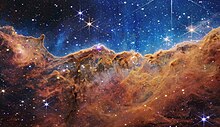
Back سديم الجؤجؤ Arabic Nebulosa de la Quilla AST NGC 3372 Azerbaijani NGC 3372 Byelorussian Nivlennad ar Garenn Breton Kobilica (maglina) BS Nebulosa de la Quilla Catalan NGC 3372 CE Mlhovina Carina Czech Carinanebel German
| Emission nebula | |
|---|---|
 The Carina Nebula. Eta Carinae and the Keyhole Nebula are left of center, NGC 3324 is at upper right. | |
| Observation data: J2000.0 epoch | |
| Right ascension | 10h 45m 08.5s[1] |
| Declination | −59° 52′ 04″[1] |
| Distance | ~8,500 ly (~2,600[2] pc) |
| Apparent magnitude (V) | +1.0[3] |
| Apparent dimensions (V) | 120 × 120 arcmins |
| Constellation | Carina |
| Physical characteristics | |
| Radius | ~230[4] ly (~70 pc) |
| Notable features |
|
| Designations | NGC 3372,[5] ESO 128-EN013,[1] GC 2197,[1] h 3295,[1] Caldwell 92[6] |

The Carina Nebula[7] or Eta Carinae Nebula[8] (catalogued as NGC 3372; also known as the Great Carina Nebula[9]) is a large, complex area of bright and dark nebulosity in the constellation Carina, located in the Carina–Sagittarius Arm of the Milky Way galaxy. The nebula is approximately 8,500 light-years (2,600 pc) from Earth.[2]
The nebula has within its boundaries the large Carina OB1 association and several related open clusters, including numerous O-type stars and several Wolf–Rayet stars. Carina OB1 encompasses the star clusters Trumpler 14 and Trumpler 16. Trumpler 14 is one of the youngest known star clusters at half a million years old and contains stars like the O2 supergiant HD 93129A. Trumpler 16 is the home of many extremely luminous stars, such as WR 25 and the Eta Carinae star system. Trumpler 15, Collinder 228, Collinder 232, NGC 3324, and NGC 3293 are also considered members of the association. NGC 3293 is the oldest and furthest from Trumpler 14, indicating sequential and ongoing star formation.
The nebula is one of the largest diffuse nebulae in our skies. Although it is four times as large as and even brighter than the famous Orion Nebula, the Carina Nebula is much less well known due to its location in the southern sky. It was discovered by Nicolas-Louis de Lacaille in 1752 from the Cape of Good Hope.
The Carina Nebula was selected as one of five cosmic objects observed by the James Webb Space Telescope, as part of the release of its first official science images. A detailed image was made of an early star-forming region of NGC 3324 known as the Cosmic Cliffs.[10]
- ^ a b c d e "NGC 3372". The NGC/IC Project. Archived from the original on 28 May 2009. Retrieved 29 November 2016.
- ^ a b Kuhn, Michael A.; et al. (January 2019). "Kinematics in Young Star Clusters and Associations with Gaia DR2". The Astrophysical Journal. 870 (1). 32. arXiv:1807.02115. Bibcode:2019ApJ...870...32K. doi:10.3847/1538-4357/aaef8c. S2CID 119328315.
- ^ Frommert, Hartmut & Kronberg, Christine (22 March 1998). "NGC 3372". SEDS.org. Archived from the original on 30 May 2016. Retrieved 26 November 2016.
- ^ "NGC 3372 – The Eta Carinae Nebula". Atlas of the Universe. Retrieved 1 October 2013.
- ^ "NGC 3372". SIMBAD. Centre de données astronomiques de Strasbourg. Retrieved 3 September 2013.
- ^ O'Meara, S. J. (2002). The Caldwell Objects. Cambridge University Press. pp. 361–369. ISBN 978-0-521-82796-6.
- ^ "The Carina Nebula: Star Birth in the Extreme". Hubblesite. NASA. 24 April 2007. Retrieved 20 November 2020.
- ^ Uranometria 2000.0
- ^ APOD, Picture of the day for 27 Dec 2018
- ^ Garner, Rob (8 July 2022). "NASA Shares List of Cosmic Targets for Webb Telescope's 1st Images". NASA. Retrieved 8 July 2022.
© MMXXIII Rich X Search. We shall prevail. All rights reserved. Rich X Search